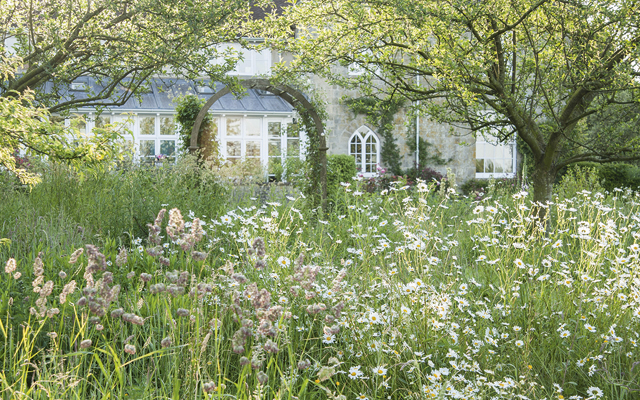How to restore an orchard meadow
An orchard or paddock can be restored into a thriving wildflower habitat, says Donald Macintyre


Most traditional farms had an orchard nearby and the orchard meadow provided grazing, often used for sick or expectant livestock. Surviving farm orchards are very important habitats for wildlife, particularly birds, bats, bees and butterflies. They are also important for the perennial wildflowers on which such fauna depends. England has lost 98% of its wildflower meadows in the past 70 or so years and traditional orchard meadows are an important refuge for the remaining 2%.
Lack of management, or poor management, over many decades has resulted in a decline of the indigenous wildflowers of orchard meadows, but it can be reversed. Frequently, such places still have a few cowslips and buttercups, but also large areas of difficult to manage and unsightly, rank vegetation including docks and thistles. A combination of sympathetic management and oversowing with a meadow seed mixture is known as ‘meadow restoration’, because you’re sowing into existing grassland. There are three stages to meadow restoration.
Prepare for seed-sowing
As a preamble to seed sowing, cut the orchard grass hard. Rake off the clippings and pile in a corner. This pile can be a permanent feature, creating a habitat for bugs and fungi and perhaps a home for amphibians and rep-tiles. Select the areas where you plan to restore your orchard meadow, being quite ambitious. Rake and scarify these patches very hard, removing dead thatch and exposing bare soil. This is important, because the bare soil will provide sites for the sown seed to germinate.
Include yellow rattle
Sow a rich mixture of meadow wildflowers and meadow grasses onto the surface of each patch at 2g–4g per sq m (when choosing your favourite species, do take account of your soil type and location seed suppliers can usually advise). Don’t rake the seeds, but firm the surface, by treading or rolling. September and October are the best times to sow, or even up to Christmas-time, but preferably not later; competition from the existing grass will give post-Christmas-sown seed little chance to develop. Do include seeds of the magic yellow rattle, Rhinanthus minor. This plant is nature’s weed-killer. It’s a partial parasite and saps the strength of coarse grasses and even thistles. It’s an annual and can be tricky to establish, but when it thrives, rank weed growth will decline, yielding space for your sown wildflowers.
Yearly management
Sign up for the Country Life Newsletter
Exquisite houses, the beauty of Nature, and how to get the most from your life, straight to your inbox.
Hard scarification and yellow rattle are the key essentials for sowing and good management is needed to ensure that your meadow establishes well over time. After an autumn sowing, yellow rattle will germinate in the spring and will flower in June. Watch out for it it’s the first indication that the sown seeds are doing well.
July is the time to cut this type of meadow. You can mow, strim or get out the scythe, but try to mow from the centre outwards, to give wild animals a means of escape through the uncut material. I like to scythe in the early morning, before the sun is too hot. Leave the cuttings to wilt, then rake off and stack them on your corner heap.
The management is the same each year. Leave the meadow to grow and flower from March to July, then cut in July later, in the north and maintain thereafter as short grass, by grazing or mowing until the following March.
Changes over time
Meadow watching is the best bit, seeing it change over time. The first sign that something is going on is a spattering of yellow rattle flowering in June, often leading to thousands of self-sown plants in years two and three. Rattle and the July hay cut will quickly suppress the coarse grasses, the docks and thistles.
After two to four years, these weeds give way, if you’re fortunate, to carpets of cowslips, moon daisies, scabious, knapweed and most of the other species you have sown. If you’re lucky and can wait longer, say 7–15 years, the first wild orchids may appear. Orchids come in as wind-blown dust seed, travelling from far off. Carefully mow around such plants until they’ve shed seed and you could have an orchard meadow brimming with naturally occurring bee, spotted, pyramidal and butterfly orchids after 15–20 years.
Donald MacIntyre is the founder and proprietor of meadow and grassland specialist Emorsgate Seeds (01553 829028; www.wildseed.co.uk)
This article was first published in Country Life magazine on September 10 2014
-
 Two quick and easy seasonal asparagus recipes to try this Easter Weekend
Two quick and easy seasonal asparagus recipes to try this Easter WeekendAsparagus has royal roots — it was once a favourite of Madame de Pompadour.
By Melanie Johnson
-
 Sip tea and laugh at your neighbours in this seaside Norfolk home with a watchtower
Sip tea and laugh at your neighbours in this seaside Norfolk home with a watchtowerOn Cliff Hill in Gorleston, one home is taller than all the others. It could be yours.
By James Fisher